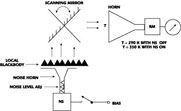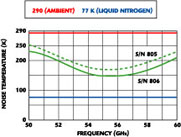Used for remote sensing in various applications and environments, microwave and millimeter-wave radiometers (RM) require frequent calibration. Microwave radiometers measure noise temperature using a suitable antenna which is designed to match a scene of interest, as shown in Figure 1 .

In a technical sense, if the antenna's main beam width is smaller than or equal to the viewing angle of an object, the radiometric system measures the temperature of such an object. To calibrate the instrument, two or more temperature levels must be introduced to the radiometer. One is usually the ambient temperature, and a local "blackbody" source is kept at ambient to obtain this reference point. The technique requires the antenna to "look" at this source only once in a while.
The second calibration temperature level can be produced by a noise source (NS) and injected into the radiometer input, as shown in Figure 2 . Its level is usually higher than ambient, and, because of that, semiconductor noise sources have their excess noise temperature (ENR) defined (for example, as 30 dB over 290 K (ambient temperature)). The directional coupler usually has > 20 dB coupling loss.

Often, radiometers measure noise temperatures deep below ambient; therefore, a source of such low temperature must be available for calibration. Liquid nitrogen boils at sea level at 77 K (-213°C), and a microwave absorber immersed in liquid nitrogen makes a good calibration standard source. Such a source, a vessel with an absorber immersed in liquid nitrogen, must be positioned before the radiometer antenna for calibration. For radiometers operated outdoors, on aircraft or ships, this type of calibration procedure becomes quite a problem.
Spacek Labs has completed research and is now introducing a noise source which produces a lower-than-ambient noise temperature at V-band, 50 to 60 GHz. Typical temperature levels over this band are 150 to 220 K, while the source is purely electronic and no cooling agent is necessary. Similar sources are being developed for K-band, 21 to 30 GHz, and other mm-wave bands.
The principle of the new noise source was previously described,1,2 but only until recently have suitable mm-wave circuits become available. Another practical "two-level" blackbody noise source was designed which allows the directional coupler for noise injection to be removed. The new design utilizes a semiconductor noise generator with a small horn that radiates its output noise through the absorber layer kept at ambient temperature, as shown in Figure 3 . Absorber insertion loss for mm-wave noise is ~20 dB, so the radiometer can be calibrated to ~290 K and 350 K with the noise generator on. The higher temperature level can be adjusted by an additional attenuator.

While using liquid nitrogen (and possibly liquid hydrogen where applicable) remains a good standard for low temperature sources, the new types of noise sources can offer a better, more available calibration for outdoor radiometric systems. Typical of the new family of noise sources, the model CS-V noise source operates over the 50 to 60 GHz frequency range with a typical output noise temperature of 150 to 220 K, as shown in Figure 4 . The source operates with a +8 to +12 VDC bias and draws 100 mA. Its output connector is WR-15, UG-385/U. The noise source requires thermostabilization (±5°C) with the radiometer to be calibrated at one level within +10° to 40°C. Additional information may be obtained via e-mail at sales@spaceklabs.com.
References:
1. H. Frater and D.R. Williams, "An Active 'Cold' Load Noise Source," IEEE Transactions on Microwave Theory and Techniques , MTT-29, No. 4, 1981, pp. 344-346.
2. R.L. Forward and T.C. Cisco, "Electronically Cold Microwave Artificial Resistors," IEEE Transactions on Microwave Theory and Techniques , MTT-31, No. 1, 1983, pp. 45-48.
3. J. Polivka, "Active Microwave Radiometry," International Journal of IR and MM Waves , Vol. 15, March 1995, pp. 1673-1683.
Spacek Labs Inc., Santa Barbara, CA (805) 564-4404, www.spaceklabs.com. Circle No. 303

